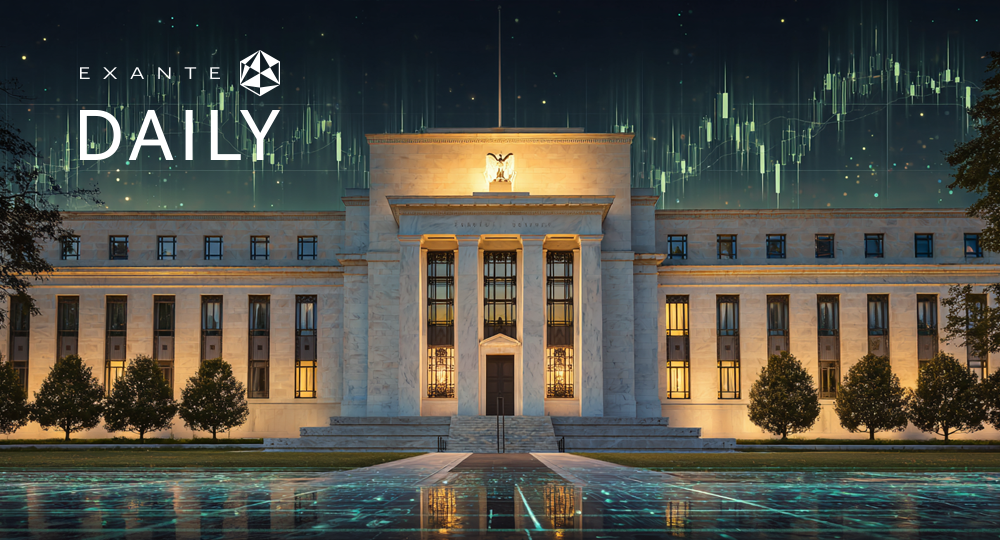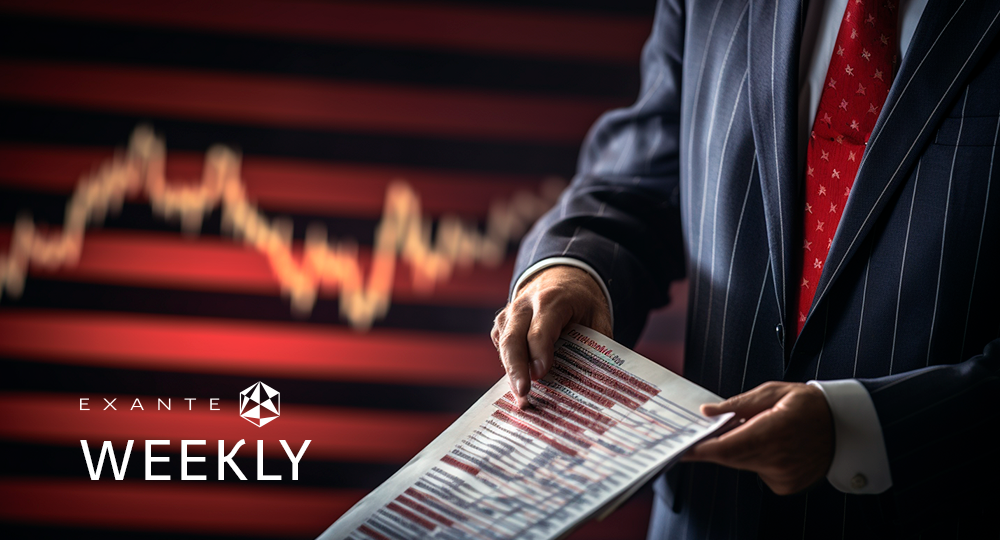
Who’s next in the firing line?

Corporate Earnings Calendar 7 August - 12 August 2025
Thursday: Eli Lilly and Co., Merck & Co., Viatris, ConocoPhillips, Expedia, Cleanspark, Gilead Sciences, Pinterest, Take-Two Interactive Software, The Trade Desk, Twilio, Monster Beverage, Martin Marietta Materials, Wynn Resorts, Dropbox
Monday: Barrick Mining, AMC Entertainment
Tuesday: Cardinal Health
Wednesday: Cisco Systems
Global market indices
US Stock Indices Price Performance
Nasdaq 100 +0.42% MTD and +10.96% YTD
Dow Jones Industrial Average -0.04% MTD and +3.68% YTD
NYSE +0.15% MTD and +7.29% YTD
S&P 500 +0.09% MTD and +7.88% YTD
The S&P 500 is +0.09% over the past week, with 6 of the 11 sectors up MTD. The Equally Weighted version of the S&P 500 is -0.41% over this past week and +4.31% YTD.
The S&P 500 Consumer Staples sector is the leading sector so far this month, +2.54% MTD and +5.05% YTD, while Energy is the weakest sector at -2.99% MTD and -1.20% YTD.
Over this past week, Consumer Staples outperformed within the S&P 500 at +1.93%, followed by Communication Services and Materials at +0.73% and +0.67%, respectively. Conversely, Energy underperformed at -3.57%, followed by Real Estate and Financials at -1.72% and -1.44%, respectively.
The equal-weight version of the S&P 500 was -0.22% on Wednesday, underperforming its cap-weighted counterpart by 0.95 percentage points.
On Wednesday, US stock indexes saw modest gains, led by the Information Technology sector. The Nasdaq Composite advanced by +1.21%, with Apple as a key driver. The S&P 500 was +0.73%, while the Dow Jones Industrial Average was +0.18%.
According to LSEG I/B/E/S data, Q2 2025 y/o/y earnings are expected to be 12.1%. Excluding the Energy sector, the y/o/y earnings estimate is 14.1%. Of the 399 companies in the S&P 500 that have reported earnings by 6th August for Q2 2025, 79.7% reported above analyst expectations. This compares to a long-term average of 67%. The Q2 2025 y/o/y blended revenue growth estimate is 6.1%. If the Energy sector is excluded, the growth rate for the index is 7.3%.
The Technology sector, at 93.0%, is the sector with most companies reporting above estimates, while Financials with a surprise factor of 9.5%, is the sector that’s beaten earnings expectations by the highest surprise factor. Within Materials, 45.0% of companies have reported above estimates, while Real Estate is the sector with the lowest surprise factor at -0.7%. The S&P 500 surprise factor is 8.1%. The forward four-quarter price-to-earnings ratio (P/E) for the S&P 500 sits at 22.3x.
In corporate news, the largest US food delivery service, DoorDash, provided a Q3 outlook for orders that exceeded Wall Street's expectations.
Airbnb issued a better-than-expected forecast for Q3, citing strong summer travel demand. However, the company cautioned that growth rates might moderate later this year due to challenging year-ago comparisons.
Advanced Micro Devices CEO Lisa Su reported positive signs in demand across all product lines and noted progress in securing US government approval to re-enter the China market.
Super Micro Computer shares fell after the company lowered its FY revenue forecast, raising concerns about sales and pricing pressures for its AI servers.
McDonald’s reported a pick-up in sales during Q2, suggesting that a strategy of pop culture collaborations and budget-friendly meals is helping to counteract consumer economic concerns.
Walt Disney disappointed investors with a cautious FY net profit forecast, which was weighed down by struggles in its movie and television divisions.
General Motors signed an agreement with Texas-based Noveon Magnetics to secure rare-earth magnets for its trucks and SUVs. This marks the automaker’s third domestic supply contract for a critical component largely controlled by China.
Mega caps: The Magnificent Seven had a mostly negative performance this week, as four members of the Magnificent Seven logged weekly losses. Over the last seven days, Apple +2.74%, Tesla +0.27%, and Nvidia +0.08%, while Meta Platforms -0.19%, Alphabet -0.22%, Microsoft -1.60%, and Amazon -5.04%.
Energy stocks had a mostly negative performance this week, with the Energy sector itself -3.57%. WTI and Brent prices are -8.44% and -9.11%, respectively, this week. Over this past week, BP +6.18%, Energy Fuels +5.73%, and Shell +0.57%, while Chevron -0.51%, Phillips 66 -3.03%, Occidental Petroleum -3.19%, ConocoPhillips -3.68%, ExxonMobil -4.60%, Baker Hughes -4.61%, Marathon Petroleum -4.88%, Halliburton -5.27%, and APA -6.38%.
Materials and Mining stocks also had mostly negative performance this week, with the Materials sector +0.67%. Over the past seven days, Newmont Corporation +9.37%, and Freeport-McMoRan +1.84%, while Albemarle -0.81%, Yara International -2.76%, CF Industries -2.96%, Nucor -3.10%, Sibanye Stillwater -4.33%, Celanese Corporation -11.67%, and Mosaic -14.11%.
European Stock Indices Price Performance
Stoxx 600 -0.92% MTD and +6.59% YTD
DAX -0.59% MTD and +20.17% YTD
CAC 40 -1.76% MTD and +3.45% YTD
IBEX 35 +0.97% MTD and +25.37% YTD
FTSE MIB +0.05% MTD and +19.96% YTD
FTSE 100 +0.34% MTD and +12.13% YTD
This week, the pan-European Stoxx Europe 600 index is -1.67%. It was -0.06% on Wednesday, closing at 541.07.
So far this month in the STOXX Europe 600, Insurance is the leading sector, +1.36% MTD and +20.30% YTD, while Health Care is the weakest at -3.63% MTD and -10.68% YTD.
This week, Insurance outperformed within the STOXX Europe 600, at +1.91%, followed by Utilities and Financial Services at +0.75% and +0.73%, respectively. Conversely, Autos & Parts underperformed at -5.11%%, followed by Health Care and Basic Resources at -5.08% and -3.40%, respectively.
Germany's DAX index was +0.33% on Wednesday, closing at 23,924.36. It was -1.39% for the week. France's CAC 40 index was +0.18% on Wednesday, closing at 7,635.03. It was -1.76% over the past week.
The UK's FTSE 100 index was +0.30% over the past week to 9,164.31. It was +0.24% on Wednesday.
In Wednesday's trading session, the Energy sector outperformed, tracking a rebound in oil prices earlier in the session. Tullow Oil lowered its 2025 production forecast to 40,000 – 45,000 barrels of oil equivalent per day after selling its Gabonese assets.
Banks also outperformed. Commerzbank beat expectations, posting a net profit of €462 million — 25% above consensus — driven by strong revenue and reduced loan-loss provisions. In contrast, ABN Amro disappointed with its Q2 results, reporting lower net interest income (€1.532 million versus a €1.577 million consensus) and a €250 million share buyback that fell short of expectations.
The Construction & Materials sector also traded higher. Balfour Beatty appointed Philip Hoare as its new CEO.
Additionally, Health Care hit new three-month lows following two significant US policy developments. The US BARDA announced it would terminate 22 mRNA vaccine development investments. Additionally, the US President outlined aggressive tariff plans targeting pharmaceutical imports, with rates potentially escalating to 250% over 18 months.
Novo Nordisk delivered strong Q2 results, with sales growing 18% and EBIT growing 40%, though its GLP-1 franchise underperformed expectations.
Bayer reported Q2 sales that were slightly below expectations, but profitability exceeded consensus thanks to a strong performance in its Crop Science division. The company's Pharma division lagged, and foreign exchange headwinds offset an improved guidance.
Fresenius posted solid Q2 results, with revenues up 10% and EBIT slightly ahead despite minor misses in its Kabi division. The company also raised its guidance.
Food & Beverage stocks were also lower. Coca-Cola Europacific Partners lowered its FY 2025 revenue growth guidance to 3% – 4% from a prior forecast of approximately 4%. The company cited softer demand in Indonesia due to brand boycotts related to geopolitical tensions in the Middle East, along with a challenging macroeconomic environment.
Other Global Stock Indices Price Performance
MSCI World Index +0.39% MTD and +10.92% YTD
Hang Seng +0.55% MTD and +24.18% YTD
The MSCI World Index is -0.12% over the past 7 days, while the Hang Seng Index is +0.55% over the past 7 days.
Currencies
EUR +2.10% MTD and +12.55% YTD to $1.1657.
GBP +1.15% MTD and +6.67% YTD to $1.3355.
On Wednesday, the US dollar declined, with the euro reaching a one-week high, as traders increased their bets that the Fed will implement more interest rate cuts this year than previously anticipated. This shift in sentiment followed weaker-than-expected jobs data for July.
With no major US economic releases on Wednesday, the market continued to focus on the implications of Friday's jobs report. The dollar index fell -0.58% to 98.19, its lowest point since 28th July, following a -1.36% drop on Friday, which was the largest single-day decline since April. Through the last seven days the US dollar index is -1.70%, -1.86% MTD, and -9.42% year-to-date.
The dollar briefly spiked during late-morning trading in New York, a move that coincided with a rise in Treasury yields. This was potentially driven by traders placing large futures bets ahead of a 10-year Treasury auction. However, the greenback extended its losses after the Treasury Department reported soft demand for the $42 billion sale of the notes.
The euro gained +0.73% to $1.1657, reaching its highest level since 28th July. This followed a +1.51% increase on Friday. The single-currency registered a weekly gain of +2.19% against the dollar.
The dollar fell -0.15% against the Japanese yen, trading at ¥147.34. This came after a -2.32% decline against the Japanese currency on Friday, its largest daily decline since January 2023. This week, the dollar has declined -1.41% against the Japanese currency, contributing to its -6.32% performance year-to-date.
In Japan, there was a divergence of opinion among key political figures regarding monetary policy. Taro Kono, a potential candidate for the next prime minister, argued that Japan must balance its budget and encourage the BoJ to raise interest rates to alleviate concerns about the nation’s finances. Conversely, ruling party heavyweight Ken Saito told Reuters that the BoJ should be cautious about raising rates due to the potential economic impact of US tariffs.
Sterling rose +0.47% to $1.3355 ahead of a highly anticipated BoE meeting today. The central bank is widely expected to cut its interest rate by 25 bps to 4.00%, marking the fifth cut in the current cycle. However, some members of the Monetary Policy Committee may vote to keep rates on hold, as inflation remains above the central bank's 2% target. Sterling has risen +0.84% this week.
Note: As of 5:00 pm EDT 6 August 2025
Fixed Income
US 10-year yield -14.3 bps MTD and -34.4 bps YTD to 4.232%.
German 10-year yield -4.6 bps MTD and +28.1 bps YTD to 2.650%.
UK 10-year yield -4.0 bps MTD and -3.5 bps YTD to 4.533%.
Longer-dated US Treasury yields rose on Wednesday, snapping a four-session decline, following a weak 10-year note auction and as the market awaits the US President's selection for a new member of the Federal Reserve's Board of Governors.
The losses for US Treasuries were driven by a soft auction of $42 billion in 10-year notes. Demand was at its weakest in a year, with the bid-to-cover ratio at just 2.35x. Primary dealers took 16.2% of the sale, the highest percentage in a year, which is typically an indicator of weak demand. This auction followed a somewhat disappointing sale of three-year notes on Tuesday and precedes a $25 billion auction of 30-year bonds.
Prior to the auction, yields briefly spiked, with the 10-year yield reaching a session high of 4.283%. This move coincided with a sharp drop in Treasury futures, which may have been a result of hedging against a potentially poor auction.
Yields have been trending lower recently, including a significant decline on Friday after a weak government payrolls report and the announcement of Governor Adriana Kugler's early resignation from the Fed. Both events had bolstered market expectations for a rate cut at the FOMC September meeting. However, data from the Institute for Supply Management on Tuesday showed a slowing in the services sector and indicated increased price pressures.
By the end of the day, the yield on the 10-year Treasury note rose +1.4 bps to 4.232%. On the longer end, the yield on the 30-year bond climbed +3.8 bps to 4.824%. Conversely, the two-year Treasury yield, which is more sensitive to Fed funds rate expectations, declined by -1.9 bps to 3.720%.
Minneapolis Fed President Neel Kashkari suggested that the Fed may need to cut rates in the near term to address a slowing economy, though he noted it is unclear how long it will take for the effects of new tariffs to become apparent. Fed Governor Lisa Cook described the moderation in Friday's hiring data as ‘concerning,’ while Boston Fed President Susan Collins stated that the current uncertainty warranted a ‘wait and see’ approach to price setting.
Over the past seven days, the yield on the 10-year Treasury note was -14.3 bps. The yield on the 30-year Treasury bond was -8.1 bps. On the shorter end, the two-year Treasury yield was -23.1 bps.
Fed funds futures traders are now pricing in a 93.6% probability of a cut in September, according to CME Group's FedWatch Tool. Traders are currently pricing in 60.8 bps of cuts by year-end, higher than last week’s 37.9 bps.
Across the Atlantic, in the UK, on Wednesday the 10-year gilt was +1.1 bps to 4.533%. The UK 10-year yield is -7.5 bps over the past seven days.
Across the English channel, 10-year bond yields across the eurozone increased, reversing a four-day trend of declines. Germany's 10-year bond yield rose by +1.6 bps to 2.650%.
Money markets are currently reflecting a high probability of future monetary policy adjustments. Traders are pricing in an approximately 60% chance of a rate cut by the ECB by the end of this year, and a 90% chance of a similar move by March 2026.
Germany’s two-year yield was up +1.5 basis points at 1.926%. On the long end of the curve, the 30-year yield advanced by +2.4 bps to +3.170%.
Italy’s 10-year yield rose by +1.8 basis points to 3.446%, narrowing the spread with German bunds to 79.6 basis points, its lowest level since April 2010.
Over the past seven days, the German 10-year yield was -5.9 bps. Germany's two-year bond yield was -4.1 bps, and on the longer end of the curve, Germany's 30-year yield was -3.4 bps.
The spread between US 10-year Treasuries and German Bunds is now 158.2 bps, 8.8 bps lower than last week’s 167.0 bps.
The spread between Italian BTP 10 year yields and German Bund 10-year yields stood at 79.6 bps, a contraction of 2.6 bps from 82.2 bps last week. The Italian 10-year yield is -8.5 bps over the past week.
Commodities
Gold spot +2.38% MTD and +28.55% YTD to $3,367.93 per ounce.
Silver spot +3.21% MTD and +31.19% YTD to $37.77 per ounce.
West Texas Intermediate crude -7.13% MTD and -9.63% YTD to $64.31 a barrel.
Brent crude -7.96% MTD and -9.78% YTD to $66.77 a barrel.
Gold prices are +2.72% this week and +28.55% YTD. Following a rally that saw prices reach a nearly two-week high, gold prices decreased on Wednesday as investors engaged in profit-taking.
Spot gold declined by -0.42% to $3,367.92 per ounce. This dip followed three consecutive sessions of gains, which were driven by weaker-than-expected US employment growth data released on Friday.
The appeal of gold as a non-yielding asset is often strengthened by economic uncertainty and a low-interest-rate environment.
On Wednesday, oil prices fell to an eight-week low, with both crude benchmarks experiencing their fifth consecutive day of losses. Brent crude futures dropped 89 cents, or -1.32%, to settle at $66.78 a barrel, while WTI crude declined 91 cents, or -1.40%, to $64.31. This downturn was primarily driven by uncertainty surrounding potential US sanctions on Russia. This week, WTI and Brent are -8.44% and -9.11%, respectively.
The market reacted to conflicting signals from the US President, who stated that his special envoy had made ‘great progress’ in talks with Russian President Vladimir Putin. These remarks created doubt about whether the US would proceed with a new round of secondary sanctions on Moscow. A potential deal to reduce sanctions would facilitate increased oil exports from Russia, the world's second-largest crude producer.
Earlier in the day, prices had briefly risen after the US President issued an executive order imposing a 25% tariff on goods from India, which he claimed was directly or indirectly importing Russian oil. This new tariff is scheduled to take effect 21 days after 7th August. India and China are both significant buyers of Russian oil.
Saudi Arabia, the world's largest oil exporter, raised its September crude oil prices for Asian buyers for the second consecutive month, citing tight supply and robust demand.
EIA weekly report. US crude oil stockpiles decreased last week, driven by a surge in exports and increased activity at refineries, according to the EIA. Crude inventories dropped by 3 million barrels to 423.7 million barrels. This decline was largely due to a significant rise in crude exports, which jumped by 620,000 barrels per day (bpd) to reach 3.3 million bpd. As a result, net US crude imports fell.
Refineries also played a key role in drawing down crude inventories. Refinery crude runs increased by 213,000 bpd, pushing refinery utilisation rates up by 1.5 percentage points to 96.9% of total capacity. This was especially pronounced on the Gulf and West Coasts, where utilisation hit its highest level since 2023. However, crude stocks at the Cushing, Oklahoma, hub did see a slight increase of 453,000 barrels.
Both gasoline and distillate inventories also declined. Gasoline stocks fell by 1.3 million barrels to 227.1 million barrels. While gasoline product supplied—a measure of demand—ticked down slightly, it remained above 9 million bpd. Distillate stockpiles, which include diesel and heating oil, also decreased by 565,000 barrels to 113 million barrels.
Note: As of 5:00 pm EDT 6 August 2025
Key data to move markets
EUROPE
Thursday: German Industrial Production, German Trade Balance, and ECB Economic Bulletin.
Monday: Italian CPI.
Tuesday: German ZEW Economic Sentiment and Current Situation Survey and Eurozone Economic Sentiment.
Wednesday: German and Spanish Harmonised Index of Consumer Prices.
UK
Thursday: BoE Interest Rate Decision, BoE Minutes, BoE Monetary Policy Report, and a speech by BoE Governor Andrew Bailey.
Friday: A speech by BoE Chief Economist Huw Pill.
Tuesday: BRC Like-for-Like Retail Sales, Average Earnings, Claimant Count Change, Claimant Count Rate, ILO Unemployment Rate, and Employment Change.
USA
Thursday: Initial and Continuing Jobless Claims, Non-farm Productivity, Unit Labour Costs, and a speech by Atlanta Fed President Raphael Bostic.
Friday: UoM 1-year and 5-year Inflation Expectations Surveys and a speech by St Louis Fed President Alberto Musalem.
Saturday: A speech by Fed Vice Chair for Supervision Michelle Bowman.
Tuesday: CPI and Monthly Budget Statement.
Wednesday: Speeches by Chicago Fed President Austan Goolsbee and Atlanta Fed President Raphael Bostic.
CHINA
Thursday: Exports, Imports, and Trade Balance.
Saturday: CPI and PPI.
JAPAN
Friday: Current Account.
Global Macro Updates
New US tariffs on India target Russian energy purchases. In a move aimed at pressuring Russia, President Trump signed an executive order on Wednesday morning to impose an additional 25% tariff on all imports from India, bringing the total tariff to 50%. The order, titled ‘Addressing threats to the United States by the government of the Russian Federation,’ comes as no surprise, as the president has been increasingly critical of India for its purchases of Russian energy, its ties with BRICS, and existing trade barriers.
Prior to the announcement, Indian officials were reportedly considering measures to appease the Trump administration, such as accelerating an export promotion plan and easing some dairy market access rules for the US.
Russia remains a central focus of US foreign policy. Special envoy Steve Witkoff held ‘useful and constructive’ talks with President Vladimir Putin in Moscow on Wednesday, according to Russian sources, as reported by the Associated Press. This tariff action also precedes a looming 8th August deadline set by the US President for a truce in the war in Ukraine, after which secondary sanctions on countries like China and India are expected to be imposed as a means of pressuring Russia.
TORO (tariffs on, risk off) begins. The US has imposed steep new tariffs on a wide range of imported goods, with the duties taking effect at 12:01 am today. The tariffs, which follow an executive order signed by the US President last week, target imports from dozens of nations.
Major industrialised economies, including the EU, Japan, and South Korea, are subject to a 15% tariff. Other nations with a small trade deficit with the US also face a 15% tariff. The tariff rates vary by region, with Southeast Asian nations such as Indonesia and the Philippines facing a 19% tariff, and Vietnam a 20% tariff.
In a social media post, President Trump stated that ‘billions of dollars in tariffs are now flowing into the United States of America.’ Given these increased revenue flows from tariffs, along with investment promises as part of these trade ‘deals’, President Trump has little incentive to reverse these policies in the future. Uncertainty around growth, inflation, Fed policy, longer term rates, and corporate and consumer outlooks will not go away even once the tariffs are 'fixed'. It will likely grow due to the correlation effects. At some stage markets will have to price in these market related risks, but for now, they are largely ignoring them.
BoE decision preview. The BoE is widely expected to cut its key interest rate by 25 bps to 4.00% today. However, the accompanying statement is likely to remain cautious, and a split vote is anticipated among policymakers. Some are tipped to support a larger 50-bps cut, while others may advocate for holding the rate steady.
This decision comes as the central bank navigates a complex economic environment characterised by upward inflationary pressures, slowing economic growth, and a weakening labour market. Amid these conflicting signals, the BoE will likely emphasise a data-dependent approach and a gradual, careful withdrawal of its policy.
The BoE’s latest macroeconomic forecasts are expected to include a near-term upward revision for inflation and may warn of the risk of inflation persistence, though inflation is still projected to return to its 2.0% target by 2027. Economic growth is likely to be revised up slightly for the near term following a strong first quarter, but little change is expected for the long-term outlook.
In addition, attention will be on the BoE’s annual review of its quantitative tightening programme. This review, which precedes the September decision on asset sale plans for the next 12 months, has become a focus as upward pressure on yields has fuelled expectations that the central bank might slow its sales to avoid undermining the transmission of its policy easing.
While every effort has been made to verify the accuracy of this information, EXT Ltd. (hereafter known as “EXANTE”) cannot accept any responsibility or liability for reliance by any person on this publication or any of the information, opinions, or conclusions contained in this publication. The findings and views expressed in this publication do not necessarily reflect the views of EXANTE. Any action taken upon the information contained in this publication is strictly at your own risk. EXANTE will not be liable for any loss or damage in connection with this publication.
Ten artykuł jest publikowany wyłącznie w celach informacyjnych i nie powinien być traktowany jako oferta lub zachęta do kupna lub sprzedaży jakichkolwiek inwestycji lub powiązanych usług, do których można się tu odwołać. Obrót instrumentami finansowymi wiąże się ze znacznym ryzykiem strat i może nie być odpowiedni dla wszystkich inwestorów. Wyniki osiągnięte w przeszłości nie są wiarygodnym wskaźnikiem wyników w przyszłości.
Zarejestruj się i otrzymuj informacje rynkowe
Zarejestruj się i otrzymuj
informacje
rynkowe
Subskrybuj teraz



